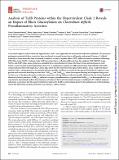| dc.contributor.author | Guzman-Verri, Caterina | |
| dc.contributor.author | Quesada-Gómez, Carlos | |
| dc.contributor.author | López-Ureña, Diana | |
| dc.contributor.author | Chumbler, Nicole | |
| dc.contributor.author | Kroh, Heather | |
| dc.contributor.author | Castro-Peña, Carolina | |
| dc.contributor.author | Rodríguez, César | |
| dc.contributor.author | Orozco-Aguilar, Josué | |
| dc.contributor.author | González-Camacho, Sara | |
| dc.contributor.author | Rucavado, Alexandra | |
| dc.contributor.author | Lawley, Trevor | |
| dc.contributor.author | Lacy, D. Borden | |
| dc.contributor.author | Chaves-Olarte, Esteban | |
| dc.date.accessioned | 2020-06-15T22:21:11Z | |
| dc.date.available | 2020-06-15T22:21:11Z | |
| dc.date.issued | 2016-03 | |
| dc.identifier.uri | http://hdl.handle.net/11056/17573 | |
| dc.description.abstract | Clostridium difficile strains within the hypervirulent clade 2 are responsible for nosocomial outbreaks worldwide. The increased pathogenic potential of these strains has been attributed to several factors but is still poorly understood. During a C. difficile outbreak, a strain from this clade was found to induce a variant cytopathic effect (CPE), different from the canonical arborizing CPE. This strain (NAP1V) belongs to the NAP1 genotype but to a ribotype different from the epidemic NAP1/RT027 strain. NAP1V and NAP1 share some properties, including the overproduction of toxins, the binary toxin, and mutations in tcdC. NAP1V is not resistant to fluoroquinolones, however. A comparative analysis of TcdB proteins from NAP1/RT027 and NAP1V strains indicated that both target Rac, Cdc42, Rap, and R-Ras but only the former glucosylates RhoA. Thus, TcdB from hypervirulent clade 2 strains possesses an extended substrate profile, and RhoA is crucial for the type of CPE induced. Sequence comparison and structural modeling revealed that TcdBNAP1 and TcdBNAP1V share the receptor-binding and autoprocessing activities but vary in the glucosyltransferase domain, consistent with the different substrate profile. Whereas the two toxins displayed identical cytotoxic potencies, TcdBNAP1 induced a stronger proinflammatory response than TcdBNAP1V as determined in ex vivo experiments and animal models. Since immune activation at the level of intestinal mucosa is a hallmark of C. difficile-induced infections, we propose that the panel of substrates targeted by TcdB is a determining factor in the pathogenesis of this pathogen and in the differential virulence potential seen among C. difficile strains. | es_ES |
| dc.description.abstract | Las cepas de Clostridium difficile dentro del clado hipervirulento 2 son responsables de los brotes nosocomiales en todo el mundo. El mayor potencial patógeno de estas cepas se ha atribuido a varios factores, pero todavía no se conoce bien. Durante un brote de C. difficile, se descubrió que una cepa de este clado inducía una variante del efecto citopático (CPE), diferente del CPE arborizante canónico. Esta cepa (NAP1V) pertenece al genotipo NAP1 pero a un ribotipo diferente de la cepa epidémica NAP1/RT027. El NAP1V y el NAP1 comparten algunas propiedades, entre ellas la sobreproducción de toxinas, la toxina binaria y las mutaciones en la tcdC. Sin embargo, el NAP1V no es resistente a las fluoroquinolonas. Un análisis comparativo de las proteínas TcdB de las cepas NAP1/RT027 y NAP1V indicó que ambas apuntan a Rac, Cdc42, Rap y R-Ras pero sólo a los antiguos glucosilados RhoA. Por lo tanto, la TcdB de las cepas hipervirulentas del clado 2 posee un perfil de sustrato ampliado, y RhoA es crucial para el tipo de CPE inducido. La comparación de secuencias y el modelado estructural revelaron que la TcdBNAP1 y el TcdBNAP1V comparten las actividades de unión a receptores y de autoprocesamiento pero varían en el dominio de la glucosiltransferasa, en consonancia con el diferente perfil de los sustratos. Mientras que las dos toxinas mostraron idénticas potencias citotóxicas, la TcdBNAP1 indujo una respuesta proinflamatoria más fuerte que el TcdBNAP1V, según se determinó en experimentos ex vivo y en modelos animales. Dado que la activación inmunológica a nivel de la mucosa intestinal es un sello distintivo de las infecciones inducidas por C. difficile, proponemos que el panel de sustratos a los que se dirige la TcdB es un factor determinante en la patogénesis de este patógeno y en el potencial de virulencia diferencial que se observa entre las cepas de C. difficile. | es_ES |
| dc.description.sponsorship | Universidad Nacional, Costa Rica | es_ES |
| dc.language.iso | eng | es_ES |
| dc.publisher | Infection and Immunity | es_ES |
| dc.rights | Acceso abierto | es_ES |
| dc.rights.uri | http://creativecommons.org/licenses/by-nc-nd/4.0/ | |
| dc.source | Infectionand Immunit Volume 84 Number 3, March 2016 | es_ES |
| dc.subject | CLOSTRIDIUM DIFFICILE | es_ES |
| dc.subject | PROTEÍNAS | es_ES |
| dc.subject | PROTEINS | es_ES |
| dc.subject | TcdB | es_ES |
| dc.title | Analysis of TcdB proteins within the hypervirulent clade 2 reveals an impact of RhoA glucosylation on Clostridium difficile proinflammatory activities | es_ES |
| dc.type | http://purl.org/coar/resource_type/c_6501 | es_ES |
| dc.description.procedence | Escuela de Medicina Veterinaria | es_ES |
| dc.identifier.doi | 10.1128/IAI.01291-15 | |


